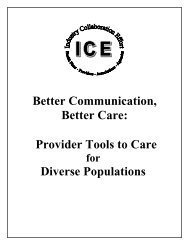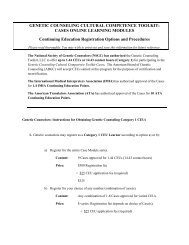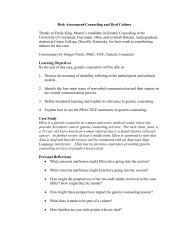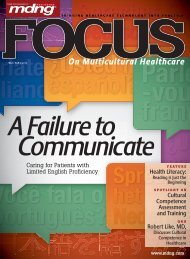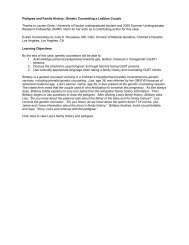Advanced Effective Communication, Cultural Competence, and ...
Advanced Effective Communication, Cultural Competence, and ...
Advanced Effective Communication, Cultural Competence, and ...
You also want an ePaper? Increase the reach of your titles
YUMPU automatically turns print PDFs into web optimized ePapers that Google loves.
A Roadmap for Hospitals<br />
Chapter Four: End-of-Life-Care<br />
• Make sure that appropriate auxiliary aids <strong>and</strong> services<br />
are available during treatment of patients who have<br />
sensory impairments.<br />
• Provide augmentative <strong>and</strong> alternative communication<br />
(AAC) resources to help with treatment of patients<br />
with communication impairments.<br />
• Note the use of communication assistance in the<br />
medical record <strong>and</strong> communicate needed aids <strong>and</strong><br />
services to staff.<br />
• Provide communication assistance to surrogate<br />
decision-makers whose preferred language is not<br />
English or have sensory or communication needs to<br />
involve the patient’s surrogate decision-maker in care<br />
discussions.<br />
❑ Monitor changes in the patient’s<br />
communication status during end-of-life<br />
care.<br />
A change in health status or a result of medical treatment<br />
or procedures can impair the patient’s ability to<br />
communicate. Patients may develop new or more severe<br />
communication impairments at the end of life, <strong>and</strong> staff<br />
should be aware of any changes in the patient’s<br />
communication status.<br />
• Determine if the patient has developed new or more<br />
severe communication impairments during end-of-life<br />
care <strong>and</strong> contact the Speech Language Pathology<br />
Department, if available. Provide AAC resources, as<br />
needed, to help during treatment.<br />
• Anticipate the communication needs of the patient<br />
who is expected to develop communication<br />
impairments from scheduled treatment or procedures<br />
during end-of-life care (for example, as a result of<br />
intubation, tracheostomy, sedation, or other<br />
interventions that may compromise the patient’s<br />
ability to communicate).<br />
• Note any changes in the patient’s communication<br />
status in the medical record <strong>and</strong> communicate new<br />
needs to staff.<br />
❑ Involve the patient’s surrogate decisionmaker<br />
<strong>and</strong> family in end-of-life care.<br />
Both the surrogate decision-maker <strong>and</strong> the patient’s<br />
family must be involved (per the patient’s wishes) to<br />
tailor end-of-life care to the patient’s unique needs. Staff<br />
should make sure that the patient’s surrogate decisionmaker<br />
<strong>and</strong> family have an opportunity to ask questions<br />
<strong>and</strong> provide opportunities for them to participate in<br />
care discussions.<br />
• Remind the patient of his or her right to designate a<br />
surrogate decision-maker.* If the patient does not have<br />
a surrogate decision-maker, encourage the patient to<br />
identify such an individual during end-of-life care.<br />
• Ask the patient which, if any, family members he or<br />
she would like to involve in end-of-life care. Family<br />
members may be broadly defined to include friends<br />
<strong>and</strong> same-sex partners. †<br />
• Many cultural groups prefer that the patient’s family,<br />
in addition to or rather than the patient, participate in<br />
decision making. This situation may seem to<br />
contradict an emphasis on patient autonomy <strong>and</strong><br />
consent; however, staff need to respect the patient’s<br />
desire to use a surrogate decision-maker even if the<br />
patient is competent. In such instances, staff should<br />
note that the patient has deferred decision-making for<br />
cultural reasons <strong>and</strong> identify the surrogate decisionmaker<br />
in the medical record.<br />
• Educate the patient <strong>and</strong> surrogate decision-maker <strong>and</strong><br />
family regarding the dying process.<br />
• Allow family to participate in end-of-life care by<br />
providing comfort during the dying process by<br />
touching, talking, playing favorite music, or<br />
participating in care activities such as washing.<br />
• Adapt existing hospital procedures to better involve<br />
the surrogate decision-maker <strong>and</strong> family in care<br />
discussions. For example, consider rescheduling patient<br />
rounds or making sure the information provided<br />
during rounds is available to the patient’s surrogate<br />
decision-maker <strong>and</strong> family members at a later time.<br />
• Provide communication assistance to surrogate<br />
* See Chapter 1: Admission (page 10) for additional information on the patient’s right to designate a surrogate decision-maker.<br />
† Family involvement is a critical issue for lesbian, gay, bisexual, <strong>and</strong> transgender (LGBT) patients <strong>and</strong> families. In some cases, biological family<br />
members may disapprove of the patient’s same-sex relationship <strong>and</strong> may try to exclude the patient’s partner from visitation or decision making.<br />
Exclusion of a primary caregiver may compromise treatment. When treating children with same-sex parents, staff should include both parents in<br />
discussions about the child’s health care, even if both do not have legal custody. See the April 15, 2010 presidential memor<strong>and</strong>um respecting the<br />
rights of hospital patients to receive visitors <strong>and</strong> to designate surrogate decision-makers for medical emergencies regardless of their status of<br />
legally recognized immediate family members at http://www.whitehouse.gov/the-press-office/presidential-memor<strong>and</strong>um-hospital-visitation.<br />
26


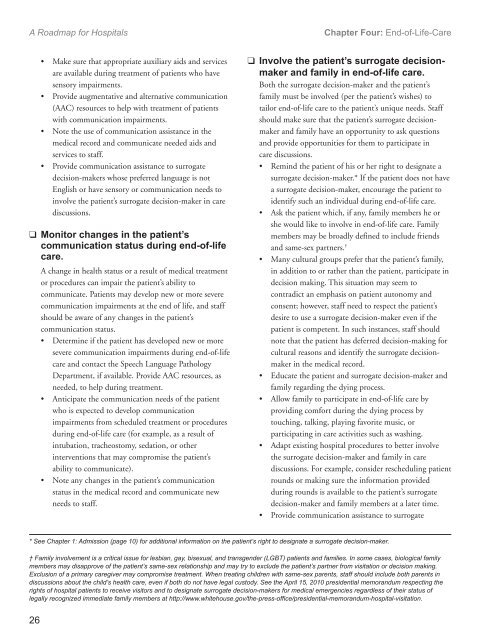
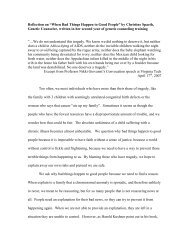
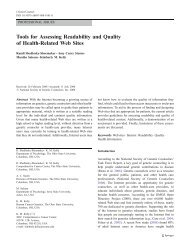

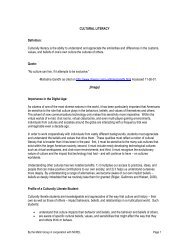
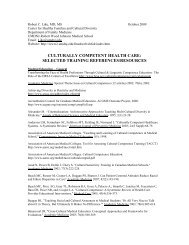

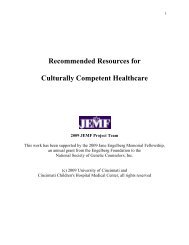

![Breaking Bad News PPT[1] - Genetic Counseling Cultural ...](https://img.yumpu.com/35003134/1/190x146/breaking-bad-news-ppt1-genetic-counseling-cultural-.jpg?quality=85)
